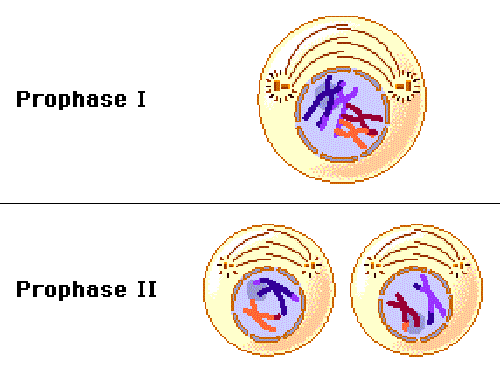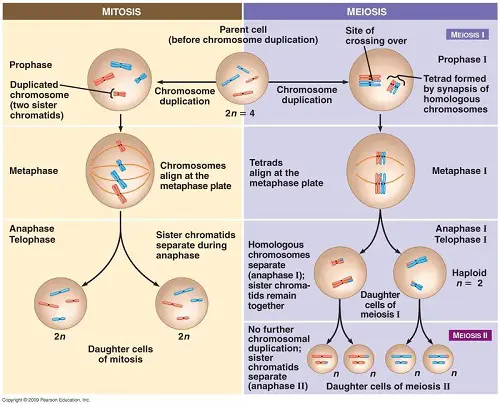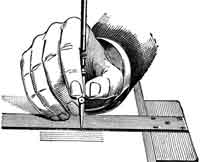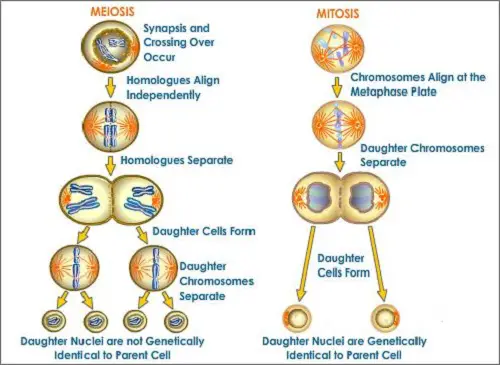
For sexual reproduction to be realized, massive cell division through meiosis and mitosis must occur. These cell divisions come in stages and not an abrupt change as many could expect. Each of the two; mitosis and meiosis has several stages through which the two are fully realized. Mitosis is the process of the cell division where the replicated cells reach a point of separating into two nuclei.
In simpler terms, it is a process through cell breaks into two identical cells through the process of cell division. Meiosis, on the other hand, is a different process all together. Here, it is the chromosomes that duplicates in the initial meiosis stage and later the chromosomes exchange their genetic information. In the later stage of meiosis II, the duplicated split to form haploid gametes. It is these two gametes that come together during fertilization to form a new cell with a complete pair of chromosomes.
Difference between the definitions of Prophase I and II
- Prophase I
This is the first stage of meiosis I. It involves the pairing and crossovers of the already duplicated chromosomes. At this point, the chromosomes gain visibility by thickening and shortening. Genetic recombination occurs at this stage because it is where crossover mainly does occur. The paired chromosomes now form bivalents. It is at this stage that nuclei and the nuclear envelope disappear thereby allowing for the spindle nuclei to enter the nucleus.
- Prophase II
Prophase II is the first stage of Meiosis II. It occurs immediately without passing through an interphase. There is no duplication at this stage. Only replication of centrioles takes place. The pair separates in prophase II. A daughter centriole forms and places itself perpendicular to the ‘mother’. The two pairs separate and form two centrosomes. At its advanced stage, the nuclear envelope breaks. A new plane is formed and is around 90 degrees to the original spindle in Meiosis I.
- Prophase
As is commonly known, pro originates from Latin and means before. Prophase, therefore, refers to an initial phase of a stage like in meiosis.
- Interphase
Inter originates from Latin just like a pro. Inter means between. Interphase therefore refers to a phase between other phases of a stage. Interphase is the phase between meiotic stages. It is characterized by a lot of latency and maturity.
Difference between the inception of prophase I and II
- The beginning stage
Prophase I begin and take place at the initial stage of Meiosis I whereas Prophase II begins in meiosis II. Prophase I is simply the first stage in Meiosis I. After a very long latent period in interphase, the developments continue next in prophase I. Meiosis I is known, to begin with an interphase after which prophase I comes in. meiosis I is the center of cell duplication and visibility. It is at meiosis I that the cell becomes visible.
All this happens in prophase I of meiosis I. On the other hand, the stage of meiosis II involves the formation of a daughter centriole from the original and separation of the same. Prophase II is the first stage of meiosis II.
- Occurrence phase
Prophase I
The duplication of the chromosomes occurs in the interphase. An interphase refers to a stage at which no cell division takes place. However, this is the most important phase as the cell performs the most vital duty of ensuring the division carries a similar copy of the original. The interphase is a long process and it occurs immediately before meiosis I. What happens in prophase I is only pairing of the homologous chromosomes and later crossover of its genetic content. As for duplication, it has already happened in interphase.
Prophase II
Totally different from prophase I, prophase II does not require an interphase. It happens immediately without passing through the interphase.
- Homologous chromosomes pairing
Prophase I
This is the only site and point where the pairing of homologous chromosomes happens. You should note that the homologs enter meiosis unpaired. Here, two members of the homolog pair simply referred to as bivalents come together and form a pair at this stage. The bivalent reshapes at this point. There follow changes that come with meiosis processes. The homolog pair now completely synapse gradually to a point of no distinction.
Prophase II
Different from prophase I, this point of Meiosis does not involve any pairing of homologous chromosomes. Firstly, this stage does not involve the use of homolog chromosomes. Secondly, this stage involves replication over pairing.
- Crossover vs no crossover
Prophase I
With the pairing of the homolog chromosomes having taken place, the next move in prophase I is for the chromosomal content to exchange within the pair. The crossover brings about mainly a change in genetic composition through recombination. The combining chromosomes are hereditary and thus not identical. The process finally leads to a total or complete synapse thus enabling the next stage to take place.
Prophase II
It is worth noting here that instead of the chromosomal cells crossover, in prophase II, the existing is actually replicating and not combining. Thus, there is no DNA crossover that can be identified at this stage. Instead of a crossover, it’s the two pairs separating into two centrosomes.
- Chromosomal types involved
Prophase I
This phase of meiosis I stage differs from the second prophase in terms of the types of the chromosomes used. This stage and phase employ the use of homologous chromosomes. Since this stage is all the about restructuring of the chromosomes and recombination. Only homologous chromosomes can perform this. Homologous chromosomes aid in crossovers and the formation of bivalents.
Prophase II
This phase involves different types of chromosomes from the earlier phase. In meiosis II, the key development is a separation of the pairs and formation of the centrosomes. This implies that only individual chromosomes are involved in this stage and phase.
- Operation plane
Prophase I
Once the homologous chromosomes have paired, the resultant item now forms a plane. This spindle apparatus is formed at the equator of the cell. This is unlike in the other stage and phase. This spindle acts as the origin from which a subsequent spindle in later stages shall be formed.
Prophase II
As opposed to the equator spindle of prophase I, this second plane is angular. Deriving its origin from the earlier spindle, this stage’s spindle form at 90˚ of the original spindle formed in meiosis I.
- Recombination vs splitting
Prophase I
As noted above, prophase I involve crossovers of homologous chromosomes. There is no crossover without exchange of genetic material within the cells involved. Once there is some exchange of genetic materials or the crossover has occurred, the material gets some recombination. The crossed materials combine with the others and exchange materials, there is a recreation of a genetic diversity. The diversity is therefore as a result of a recombination that has taken place.
Prophase II
As recombination arises from crossovers of genetic materials in homologous chromosomes, it is worth noting that this cannot occur in meiosis II and thus cannot be found under prophase II. There is no recombination and on the contrary, it is the separation that is found.
- Exchange of genetic material.
Prophase I
As noted in the above argument, prophase I involve crossovers, recombination, and exchange of genetic materials. The new tetrads are as a result of the exchange of genetic materials. The formation chiasmata involve the exchange of genetic materials.
Prophase II
Replication of centrioles and separation of the pairs does not in any way involve the exchange of genetic material. The processes happen in haploid cells and since it involves no pairing, there is no exchange of any material.
- Types of cells involved
Prophase I
Since this phase involves recombination and crossover of materials, only diploid cells are involved. These are the only cells that do come together, exchange parts and content and end up with a diversified genetics. This is the main reason unto why this phase only uses diploid cells.
Prophase II
In this phase of meiosis II, there is no involvement of pairing of chromosomes. This therefore, calls for the use of the single sets of unpaired cells which in this case are haploid. These are the cells with half the number of chromosomes needed in a gamete. Instead of the full 46, haploids come with 23.
Conclusion
The olden believe that prophase I and II are in some ways similar should not be considered as an unfounded. The differences between the two are as day and night. One occurs in meiosis I and the other in meiosis II. Prophase I involve the duplication of centrosome while prophase II does not. The first involves homologous chromosomes while the second deals with the individual chromosome. Further, the first happens in diploid cells while prophase II does so only in haploid cells. The plane from which prophase II spindle forms is at the right angle to the spindle formed in prophase I. The other very clear distinction between the two is or whether crossover, exchange of materials and pairing does take place. Prophase I has all these happening while prophase II does have none of them.
The myth that does exist that these two are non-distinctive does hold water and has been demystified already. The two are very distinct from each other and should not be confused under whatever circumstance.













Leave a Reply